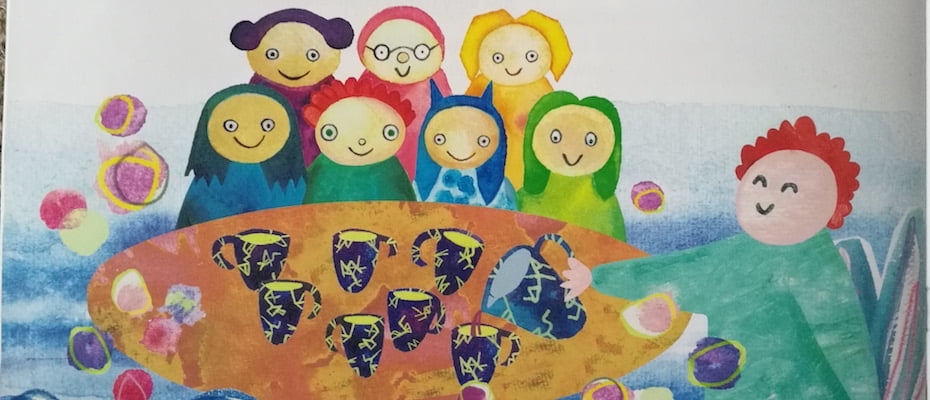How monsters wish to feel

One morning I woke with the resounding idea to write a children’s story to explain the concept of resilience to children, their teachers and their families. The idea struck me like a chord and the name of that story was: How Monsters Wish to Feel.
The story
How Monsters Wish to Feel is about a journey to develop emotional resilience. It describes the behaviour of seven monsters who live in a fantasy land and who go on a journey which ultimately transforms them. Each monster carries a strange cup to help them drink from a nearby river. Each cup has a problem specific to that monster and their way of relating to the world around them, which means the monsters never fully quench their thirst. To begin with, the characters are too preoccupied with their problems: the flaws in their cups and their thirst. These problems over-shadow not only their needs, but also their capacity to be loved and to be resilient, turning them into ‘monsters’ who live in a forgotten forest.
One night, there is a flood, and the monsters are swept away by the current of the river. The displaced monsters are finally washed up on a beach near the sea. Weary and worn down, the monsters seek each other’s support, comfort and friendship and huddle together for warmth by the edge of the sea. The story concludes with an imbalance having been redressed. The children’s vulnerabilities and apparent ‘brokenness’ have been outweighed, outshined by protective factors and strengths – their eventual gilded cups being a visual representation of this transformation and ultimately depicting a shift in our own perception of the monsters.
Are we seeing the child?
How Monsters Wish to Feel is a story about how a child’s needs can sometimes become distorted, so that the needs we see expressed through outward behaviour (the monster) mask the true, hidden emotional needs that go unmet. It therefore depicts a tale of expressed needs versus hidden needs (Geddes, 2005) through the analogy of ‘monsters’.
The story also alludes to the importance of focusing on the strengths and protective factors in a child’s life, rather than the problems and risks, in order to promote emotional resilience. A key message of the story is that adults must also consider carefully how they perceive vulnerable children. Children with social, emotional and mental health needs can be described as ‘damaged’ or seen as ‘little monsters’. However, as Richard Rose (2012:13) summarises:
In essence: children are not monsters; they have had monstrous things happen to them and sometimes these monstrous things are replicated by them as they communicate their trauma.
As adults we can acknowledge that we too are sometimes ‘so bothered by their thirst’ that we don’t help students to ‘fill their cups’. In other words, we focus on the expressed behaviour, the problems, and not the hidden unmet needs. Contrasted against the very visible outward behaviour lie invisible emotional needs that may remain unrecognised.
There are children and young people who come into school with a feeling that a monster rages inside of them. These monsters are not the cute, cuddly monsters from cartoons; rather, these monsters are the very real chimeras typical of classical mythology who represented elements of the human condition. Towering monsters of grief, torment, loss and separation that engulf and paralyse children, inhabit their inner world, leaving them completely swamped, overcome and exhausted – with little space to focus on learning. Adults around the child or young person need to delve deeper to discover what lies beneath the ‘monstrous’ behaviour of the troubled child or young person; to allow them an outlet for their complex inner worlds, in order to support them to learn and relate better in the outer world of the school and wider environment.
Shifting from ‘risk’ to ‘resilience’
Research in the social and behavioural sciences has historically adhered to a problem-focused approach when studying human and social development (Benard, 1991). This ‘pathology’ or ‘deficit’ model of research has traditionally examined problems, disease, illness, maladaptation, incompetence, or deviance, and attempted to identify their concomitant risk factors (ibid., 1991; Henderson and Milstein, 2003). There are several conceptual problems with risk research (cf. Howard et al., 1999). There are also important methodological difficulties.
Problem-focused studies are often retrospective in design: a group of adults with identified problems are examined to find specific past ‘risk factors’ such as family addiction, poverty, neglect, negative school climate, community disorganisation, and lack of access to basic human needs that correlate with their current environmental conditions (Henderson and Milstein, 2003). This does not clearly show cause and effect. More significantly, risk research paints an inaccurate impression of the outcomes of risk exposure and uses a research design that only serves to ‘perpetuate a problem perspective and implicate an inevitability of negative outcomes’ (Benard, 1991:2).
These difficulties with risk research led to two major new developments in the area of risk. Firstly, in the 1950s several researchers who had become dissatisfied with the deficit model of studying human development began to focus on individual and systemic strengths (Howard, et al., 1999). Their aim was therefore to try to understand what makes people ‘rise every time they fall’, or, ‘resilient’. Later on, several researchers aimed to study risk using a prospective research design. It was thought that the children studied in these projects would develop various problems as they grew into adolescence and adulthood. However, instead, a consistent and unexpected finding emerged: a greater percentage of the children studied developed into healthy, competent young adults (Benard, 1991).
Two of the most important studies of children ‘at risk’ were carried out by Werner and Smith (1988, 1990) and Garmezy and Rutter, (1983). Both Garmezy and Rutter’s (1983) study of more than 200 children in urban settings in mainland USA and Werner and Smith’s (1988) seminal study of 700 children, born on the Hawaiian island of Kauai in 1955, found that the majority of children, despite the high risk environments in which they grew up, developed into healthy conventionally defined ‘successful’ young adults (Howard et al., 1999). Werner and Smith (1992:202) have concluded that what is needed is ‘a corrective lens – an awareness of the self-righting tendencies that move children towards normal adult development under all but the most adverse circumstances’. This was considered to have great potential for educators.
Harnessing resources to ‘tip the balance’
Nowadays psychologists generally acknowledge that ‘Resilience is the process of harnessing biological, psychosocial, structural and cultural resources to sustain wellbeing’ (Panter-Brick and Leckman, 2013). This definition implies that resilience is a process – not a characteristic. For the process of resilience to occur there needs to be, first, resources available to an individual or group and, second, the individual or group also need to be capable of ‘harnessing’ the resources.
Gilligan (2009:9) encourages professionals to ‘tilt the balance in the child’s life in favour of protective factors’. He uses the image of weighing scales with negative or adverse weights on one side, and positive or protective factors on the other; we can either remove weights from the negative side, or add countervailing weights to the positive side. However, it should be acknowledged that it may be sometimes more feasible to add positive weights than to remove negative weights.
Resilience is not sweeping the negative away; it is expanding our view of the negative to make sense of it, whilst also assimilating and allowing greater focus on what matters, what is needed to support a continued course towards a desired and meaningful outcome – our life’s wishes. In other words, we can galvanise the strengths in a young person’s life to bring about a kind of alchemy within that young person; a seemingly magical process of transformation, creation or combination, which ultimately welds together brokenness.
Resilience, not invulnerability
Adults can view children more accurately with a ‘resiliency attitude’ that recognises that all children have strengths, silver linings and nuggets of gold in their lives, no matter how small, that can be used to promote their powers of resilience and help them to heal. But this does not mean that we sugar coat difficulties, cover problems with a sticking plaster, or view risks with rose-tinted glasses as if they are not really there; nor does it mean that we do nothing to prevent cracks from appearing in the first place by safeguarding children as far as possible from risk of harm. It is unrealistic and unhelpful to rely on a strengths or resilience-led perspective in circumstances of extreme adversity (Fraser et al., 1999).
Resilience is not about invulnerability, but our capacity to cope. Robbie Gilligan warns that children are not indestructible in the face of continuous and extreme adversity (2009:9):
A child who may show resilience is not invulnerable. Children cannot withstand unscathed, ever-increasing levels of stress. Past a certain threshold of increasing adversity, any child is likely to buckle and succumb to the pressure.
In other words, resilience needs to be nurtured in children and young people, but sometimes it needs fighting for by the adults around the child.
Nurturing relationships
Alongside resilience research runs a golden thread of nurturing relationships. Resilience in development has been described perfectly by Masten (2014) as ‘ordinary magic’. Ann Masten (2014:7-8) affirms that:
Evidence strongly suggests…that resilience is common and typically arises from the operation of basic protections. There are exceptional cases, where children overcome heavy odds because of extraordinary talents, luck, or resources, but most of the time, the children who make it have ordinary human resources and protective factors in their lives. Resilience emerges from commonplace adaptive systems for human development, such as a healthy human brain in good working order; close relationships with competent and caring adults; committed families; effective schools and communities; opportunities to succeed; and beliefs in the self, nurtured by positive interactions with the world.
The way we perceive a child, our beliefs and description of that child, profoundly influences the way we behave towards them and their own path of development; it can be the difference between humanising and de-humanising, between inclusion and exclusion, between salutogenesis and pathogenesis and between resilience and risk. The therapist Michael Durrant, has articulated this in his book on residential child care:
My experience is that, the more I strive (and, sometimes, struggle) to see my clients as competent and successful so the more they tend to demonstrate these characteristics (and, at the same time, the more I simply don’t notice their deficits or pathology).
(Durrant, 1993:186 quoted in Gilligan, 2002:25)
Resilience then, is like beauty; it is often in the eye of the beholder. An attitude of resiliency is about adults holding out hope for a child or young person – looking for the faintest rainbow amid a storm of adversity or kindling a bright flame from the smallest spark. All of these little things can help a young person to develop and strengthen their own ‘self-righting’ mechanisms so they can continue life on an even-keel:
One thing going well may change a child’s perception of themselves, and what is possible.
Gilligan (2001)
With this comes the suggestion that a pre-written, pre-determined narrative of risk does not have to dictate the life story of a child at risk; resilient children can and do emerge from behind the mask of a negative identity. Children can change, and many will heal, without any need for costly or complicated interventions, if only our education system afforded young people the free time and protected space within school in which to do so.
Change is always possible
The idea that change is possible is a simple yet powerful message of hope for vulnerable children and young people. Being able to change safely is important for all students, not just those at risk.
As such, let us maintain the sanctity of childhood, rather than imposing our own adult paradigms upon it. Let us keep school as sanctuary; free play as sacred and teach children the wonderful vocabulary of resilience. Teach them the lexicon of love, strengths, interests, friendships and creativity. These key elements of resiliency will nurture their backbone of steel, their inner keel and an outer armour to help them face (if not embrace) adversity.
So, how do Monsters wish to feel?
The last paragraph of the story answers the question inherent in the title of the story, ‘How do monsters wish to feel?’ They want to feel beloved, as well as to feel empowered, engaged, connected and able to cope. This story therefore hopes to validate the importance of positive psychology and the use of a strengths-based approach when working to facilitate change with children and young people, be that as a teacher, therapist or parent.
This is an abridged and edited extract from the book: Nurturing Emotional Resilience in Vulnerable Children and Young People by Juliette Ttofa published by Routledge in October 2017.
Juliette was invited to write this feature article following the publication of her books
References
Benard, B. (1991). Fostering Resiliency in Kids: Protective Factors on the Family, School and Community. Portland, OR: Western Regional Centre for Drug-Free Schools and Communities.
Fraser, M., Richman., J. and Galinsky, M. (1999). Risk, protection and resilience: Towards a conceptual framework for social work practice. Social Work Research , 23 (3), 131–143.
Garmezy, N. and Rutter, M. (1983). Stress, Coping and Development in Children. New York: McGraw-Hill.
Geddes, H. (2005) Attachment in the Classroom: The Links Between Children’s Early Experience, Emotional Well-Being and Performance in School: A Practical Guide for Schools. Duffield: Worth Publishing.
Gilligan, R. (2001). Promoting Resilience in Children in Out of Home Care. London: British Agencies for Adoption and Fostering. The Glasgow Centre for the Child and Society, 18th March 2003.
Gilligan, R. (2009). Promoting Resilience: Supporting Children and Young People Who Are in Care, Adopted or in Need. London: BAAF.
Henderson, N. and Milstein, M.M. (2003). Resiliency in Schools: Making it Happen for Students and Educators. Thousand Oaks, CA: Corwin Press.
Howard, S., Dryden, J. and Johnson, B. (1999). Childhood resilience: Review and critique of literature. Oxford Review of Education, 25 (3): 307–323.
Masten, A (2014). Ordinary Magic: Resilience in Development. New York: The Guilford Press.
Panter-Brick, C. and Leckman, J.F. (2013). Editorial commentary: Resilience in child development – interconnected pathways to wellbeing. Journal of Child Psychology and Psychiatry, 54 (4): 333–336.
Rose, R. (2012). Life Story Therapy With Traumatized Children: A Model for Practice. London: Jessica Kingsley.
Werner, E. and Smith, R. (1988). Vulnerable But Invincible: A Longitudinal Study of Resilient Children and Youth. New York: Adams, Bannister and Cox.
Werner, E. and Smith, R. (1990). Overcoming the Odds: High Risk Children From Birth to Adulthood. New York: Cornell University Press.
Werner E. and Smith, R. (2001). Journeys From Childhood to Midlife: Risk, Resilience and Recovery. Ithaca, NY: Cornell University Press.





Really enjoyed reading this well-written article. Lots to think about. Thanks Juliette.
Thoughtful and informative – thank you